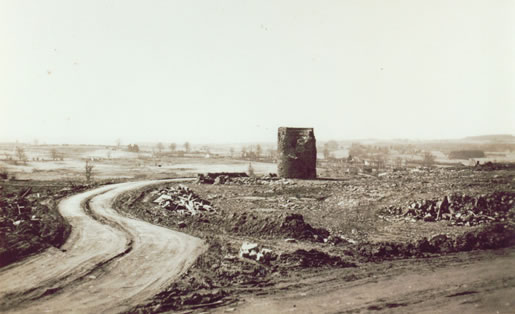Keine |
World Wars and the ‘petite farce belge’
 After the first World War of which 57 citizens of Sankt Vith did not return, the Prussian district cities Eupen and Malmedy were assigned to Belgium under the Treaty of Versailles.
After the first World War of which 57 citizens of Sankt Vith did not return, the Prussian district cities Eupen and Malmedy were assigned to Belgium under the Treaty of Versailles.
By means of a ‘public inquiry’ (1920) that was named ‘petite farce belge’, it was ‘concluded’ that the majority of the people wanted to be part of Belgium. Of the over 33.000 eligible voters, only 271 had registered to vote and by doing this had chosen to remain in Germany. These people thus experienced many repressions and fault-findings from the Belgian government.
As a result of this ‘public inquiry’ a lot of German train personnel was transferred from Sankt Vith to Möderath whereby the government did not take in account the year-long friendships and family relationships.
After a five-year long transition period (Government Baltia), the area of Eupen, Malmedy and Sankt Vith was added to the Belgian federal state in 1925. The change of fatherland was for many, as expected, a heavy burden although favourable economic circumstances offered a possibility to come to terms with this new situation. A growing population and strong building activities during the interim years of war, testify of an economic prosperity that slowed down after the worldwide economic crisis of 1929.
After the entry of the German troops on 10 May 1940, the area of Eupen-Malmedy-Sankt Vith was added to the National Socialist Deutsche Reich by the Führer Adolf Hitler and was sucked into the disturbances of the Second World War. The other National Socialist organisations of the Reich also recruited members here. Many conscripts had to fulfil their military service with the German forces (Wehrmacht) against their will. This turned them into enemies of the Belgian state at the end of the war.
Sankt Vith felt the first consequences of the war on 9 August 1944, when the church and train station were destroyed by bombs: six people lost their lives. On September the 3th the order came through to evacuate which most people obeyed. They left the city with a heavy heart in the direction of Hannoversch-Münden and Dransfeld. The Americans occupied the city in the middle of September and the Belgian government took over the control. On 16 December the Ardennes Offensive started with, amongst other, the bombardment of Sankt Vith. However, the capture of the city failed and, in this way, foiled the whole Offensive which then developed into a war of positions. Before Christmas, German forces, once again, moved into Sankt Vith.
On both Christmas Days the catastrophe broke out over Sankt Vith: allied bombers turned the city in debris; 153 citizens of Sankt Vith and more than 1000 soldiers died on these two days alone. Almost 600 buildings were destroyed or heavily damaged (more than 90%).
Notwithstanding this tragic happening, the inhabitants of Sankt Vith built up their city again on the same spot. The rubble of the bombarded city became the ‘Millionenberg’ and life returned to the emergency houses of this ‘new city’.
The reconstruction lasted until the 60s: the hospital (reopening in 1953), the church (initiated in 1959), the schools and of course the many private buildings were built again and, in this way, healed the wounds that were made by the war.
Sankt Vith developed once more into a business centre of near and far. Stock-, farm- and year markets, business- and agriculture exhibitions as well as newly opened stores and companies were witnesses of an economic prosperity. The growing traffic had a negative effect on the train station which, because of the by the war destroyed infrastructure and decreasing demand, was not competitive anymore and finally was demolished. In the train station we now find the Heimatmuseum (Regional Museum).